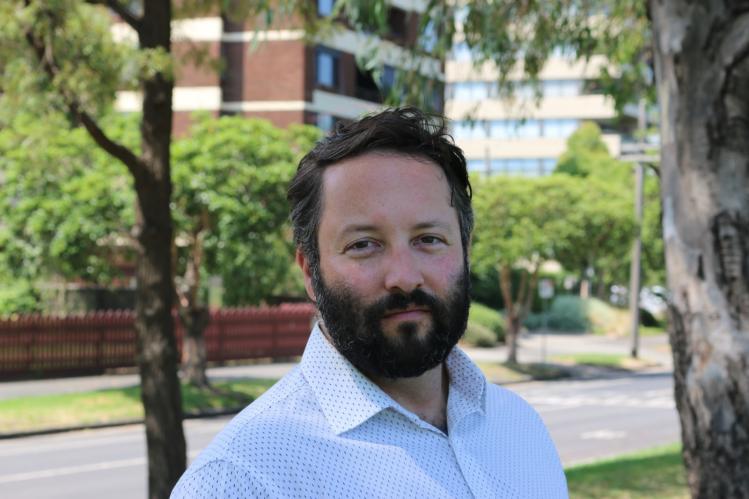
Max Holleran, a sociologist at the University of Melbourne, is the author of Yes to the City: Millennials and the Fight for Affordable Housing. It’s a detailed ethnographic study of the growing YIMBY (Yes In My Backyard) movement, which seeks to solve the U.S. housing crisis by “building more of everything.” Holleran spoke about it recently with Associate Editor Griffin Oleynick for the Commonweal Podcast. This interview has been edited for clarity and length, but you can listen to their full conversation here:
Griffin Oleynick: Before we get into the origins of YIMBYism, could you give us a brief summary of how Americans’ views on cities and the desirability of living in them have changed over the past hundred years?
Max Holleran: Americans are famously suspicious of cities. They’re places of immigration, of ethnic and racial difference, and of new ideas, some of which seem rather dangerous. And then there’s the structural aspect, including the federally funded highway system built in the postwar era. We subsidized new housing at the edges of cities—the first generation of American suburbs erected in the 1960s. All of that has made the United States a highly suburban country. West of the Mississippi, there’s a debate about whether true cities exist at all. There are sprawling metropolitan regions without true centers. Some have downtowns, strip malls, and shopping centers, but in general they’re very dispersed.
For a long time, that was the ideal: you have a family, a middle-class job, and a house away from the city center that provides a safe place to raise children. You prioritize the nuclear family, and owning a suburban house becomes your primary asset, which gives your family equity.
That started changing with the critiques of suburbanization that emerged in the 1970s. Suburbs began to be seen as culturally deadening places—not just boring and soulless, but also sometimes creepy and unwelcoming. They advertised a sense of community, but didn’t actually deliver. The kind of neighborliness that you’d see in a more compact neighborhood just wasn’t there.
Suburbs inspired criticism for environmental reasons, too. They were devouring land near cities, forcing municipalities to build highways and services far from city centers, and forcing people to drive long distances. All those critiques added up to a general dissatisfaction with suburbia that then translated into a resettling of cities beginning in the 1970s and ’80s and really accelerating in the 1990s.
Despite the pioneer metaphors about coming back to the city, American cities weren’t actually empty. They’d always had people—fewer people, but they had poor people, people of color. They had residents, just not necessarily ones who specifically chose to live there.
And the services that those people received were horrendous. The streets were in disrepair. Schools and infrastructure were quite bad. But people fell in love with cities again in the 1990s and engaged in the process we now call gentrification. That’s a uniquely American concept because most cities in Europe and around the world never lost their wealthy residents.
GO: Gentrification is a word that we hear often. How would you define it as a sociologist, and how does that compare to the popular understanding of gentrification?
MH: “Gentrification” comes from the gentry—that is, wealthy people—leaving their expensive suburbs to move back into the city. So there’s an economic dimension: people are searching for cheaper housing at the individual level, and real-estate developers are searching for housing to flip.
There’s also cultural gentrification, when people, usually middle-class and white, move into immigrant neighborhoods and find an appealing level of authenticity there. The new residents like the fact that the neighborhoods are denser and more urban, and they sometimes even celebrate the grittiness, the sense that they’re “real” places with “real” problems. However, when people move to those neighborhoods—they’re often middle-class artists, students, or young people looking for cheap rent—they quickly change them, which increases their prestige and value, displacing the original residents. And then, ironically, the first and sometimes second wave of gentrifiers are also displaced.
GO: I want to turn to the economic and social crisis at the heart of your book: inequality precipitated and perpetuated by the lack of affordable housing across the country. Rents and home prices have risen to all-time highs. What are some of the chief causes of this crisis? And how do YIMBY groups emerge as a response?
MH: Even before the pandemic, there was an enormous surge in prices not just in coastal cities, but everywhere. One major reason is general economic inequality. Real wages haven’t increased since the 1970s. Most people, particularly younger people, are living with far fewer financial assets than they would have had thirty years ago. And there’s been a steady erosion of the middle class. That’s the macroeconomic problem.
On a physical-space level, cities haven’t been building enough housing—not just public or affordable housing, but housing in general and apartments in particular. Many cities should have grown much more. Sometimes, they passed growth off onto nearby suburbs, because they didn’t want to be bothered with it. Or they refuse to grow altogether, most famously in San Francisco, where YIMBYism originated. San Francisco should be a much larger city. Instead, the Bay Area has taken on a lot of that burden, which means that people are saddled with extremely long commutes. They’re also often housing-insecure—couch surfing or lacking a stable place to stay.
In response, the YIMBYs have a simple argument: because this is a supply problem, we need to build more housing in order to achieve affordability. And we need to build more housing in every category. It’s not just about building public housing. It’s not just about building nonprofit housing. We also need to let developers build for-profit housing—which is not a popular position because, in most circles, developers are not popular people.
GO: Are the YIMBYs right that simply building more housing will increase affordability in American cities? What are some of the objections to that argument?
MH: Building more housing is in some ways a pressure valve that will help address the issues of gentrification and people getting priced out of their neighborhoods. At the same time, building market-rate housing is not going to solve the major problems because many people cannot afford the market rate.
So there has to be some form of subsidy, whether from a nonprofit or the government—something that looks like Section 8 vouchers, or something that involves mandatory affordability in the zoning process, where developers must set aside 15 percent of new units in a building as permanently affordable. Building alone will not solve the problem, particularly for people in danger of being homeless and those on the lowest rungs of the income ladder.
GO: How do you explain the rapid growth of the YIMBY movement? What is the source of its appeal?
MH: It’s a really simple message. It has a base of more affluent supporters than most previous housing movements—middle-class people who are struggling to pay the bills. You can criticize YIMBYs for worrying mainly about the middle class, but the movement has been effective at translating wonky urban-planning knowledge to a big audience.
It’s huge on Twitter and Instagram, with a lot of memes and snappy sayings. The strong presence online is also controversial because YIMBYs aren’t shy about saying what they want or calling out people who don’t want more housing. YIMBYs have been successful in going to zoning board meetings and saying, “We have to build this building. We don’t care if it increases traffic. We don’t care if it casts a shadow over your backyard.” So they have that really powerful foil of NIMBYism.
I think most of us are at least partially NIMBYs in the sense that we want to protect our homes as sources of value. Most people would probably say: “I’m a sensible homeowner. I don’t want to say no to a preschool, or something that’s socially purposeful”—but in the end, most people usually do. They say no to the hospital, the assisted living facility, the methadone clinic. NIMBYism is predictable and understandable, but it also makes it hard to build urban-planning policy. YIMBYs would say their movement is successful because people were so tired of exceptions being made for individual neighborhoods and tired of having to go through massive amounts of red tape to build anything because so many neighbors’ groups protested.
GO: YIMBY activists also use generational framing: the younger, assetless renters against the older, well-off homeowners. Why?
MH: YIMBYs often divide themselves into renters versus homeowners, and also into younger people versus older people. That’s partially because it was much easier and cheaper to buy a home thirty years ago. Buying a home now seems like a real luxury, even for people with pretty good incomes. That generational story—that older people just can’t understand how different the housing market is—has power. It universalizes the concept to everyone under forty-five in the United States, and that’s a big group of people.
It also touches on other issues within the Millennial cohort, which was adversely affected by the 2008 financial crisis. Their savings were depleted and their lifelong earnings were permanently affected by unemployment or lack of promotions. They feel like they’re living in a gerontocracy, and housing policy is just one part of that. Everything is controlled by older people who have nice homes and more money. Heads of government are all in their late seventies. Millennials as a generation, even though they’re approaching middle age, haven’t gotten as much of a political voice.
Now, younger people are proud of living in a much more urban and diverse generation. They didn’t come of age in an era of white flight and suburbanization. They place cultural value in cities, arguing that it’s good to rub shoulders with people—to embrace the Jane Jacobs dream of living in a “sidewalk ballet.” That’s a bit of an idealization of city life, but it captures the sense that things are changing quickly in the United States, and that if we could live a bit closer together, perhaps we could better understand each other and make less polarized decisions.
GO: You’ve made case studies of different cities, including Boulder, Colorado. Many people associate it with freewheeling environmentalism, but you explained that environmentalism actually prevented growth, making Boulder one of the most unaffordable, unequal places in America. How did that develop, and how have densification activists tried to combat it?
MH: Some people remember Boulder as a hippie haven—a town “between the mountains and reality.” It’s a leader when it comes to environmental policy: the city bought a green belt in the late 1960s, using public tax dollars to secure municipally managed land. The result is an incredible infrastructure of trails, an “emerald necklace” around the city that has made it rightfully famous in the United States as an outdoor enthusiast’s paradise.
The issue is that Boulder never changed zoning rules to accommodate more apartment buildings. Now, they’re slowly building more and increasing the population, but for a long time they were very influenced by an idea of almost-zero population growth. Many of the former city council members were adamant that the population not grow by more than 1 percent per year, which allowed it to remain a city of about a hundred thousand people for decades. They slowly started losing residents with smaller incomes who moved to the satellite cities around Boulder and commuted in—which, if you think about the green belt as a way to reduce suburban sprawl, made it a complete failure. Boulder is home to a large university, but many college professors now can’t afford to live in the city. Many other people who have fairly high incomes have been forced out of what has become a luxury resort city.
Boulder has always had a fraught relationship with seeing itself as a city. It wants to be a college town, despite having important industries and over a hundred thousand residents. But I think it’s also a good metaphor for a lot of other places that refuse to grow and build new housing, particularly multi-family units. They act like everyone should just go “somewhere else”—to the suburbs, the nearby cities—because the city doesn’t want to be bothered, and the residents got there first. The YIMBYs rightfully see that as a perverse refusal to acknowledge economic inequality or people’s desire to be mobile. People want to follow economic opportunities, which are in cities. Places like the University of Colorado in Boulder are at risk of losing students because they’re just too expensive. Like so many places, the city can feel more like a walled medieval town, excluding all the people who weren’t part of the original populace.
The result is a polarization of cities: some really wealthy cities and then the “service cities” next door, where the people who work in the kitchens, the nurses, and the essential workers live. But people don’t want to be banished somewhere else, even if the other place is nice. They want to feel like they’re part of a community. They don’t want the bifurcated identity of working in one city and living in another, or to be consigned to what Pope Francis calls “the periphery.”
GO: You’ve also studied Austin, Texas, one of the fastest-growing cities in the United States. How has development in the past ten or twenty years in Austin affected lower-income neighborhoods, especially in East Austin?
MH: Austin is the state capital, but it also had the vibe of a cool, slacker city more famous for live music and a countercultural scene than for having a large economy. That really changed about twenty years ago.
Austin has one of the country’s top research universities, which has always been incredibly productive in developing intellectual property and tying academic discoveries to business. But more and more, Austin became a destination not just for people who liked going out to hear live music, but for large companies and startups. It’s a huge tech center now, partly because of Texas’s growth in general.
But Austin has also lost a lot of its population, particularly its African American population. It’s become a much more expensive place to live. And that means that people have been moving to East Austin, a Black and Latino neighborhood separated by the highway. It’s an urban-planning artifact of residential segregation.
There’s been a push to grow more, to build new houses and multi-family accommodation. Because so much of Austin is dominated by bungalow houses, there’s a particular need to build multiple buildings on the same lot—but rezoning parts of Austin is a major battle. Sometimes, there are minimum-lot-size requirements that necessitate building a large house. You need the entire neighborhood rezoned or you need to get zoning approval on a particular plot of land.
Building a more vertical, walkable city, where people are located near their jobs and commerce, is difficult to do in a place dominated by cars and single-family homes. You don’t get the density that gives a sweet spot of shops people can walk or bike to.
GO: How do you think responsible development should happen? What are some policy alternatives to building market-rate housing?
MH: One major issue is that we ask urban planners and architects to solve a lot of problems for us. One of those problems is poverty and a lack of fair wages. We’re not going to solve this problem unless we start paying people more. People who are paid by the hour and haven’t seen the minimum wage go up are going to find it hard to afford any kind of housing.
There needs to be a meaningful reinvestment in durable public housing that can withstand natural disasters, heat waves, and flooding. We can also support more cooperative and grassroots endeavors like community land trusts, where people set up nonprofit groups to collectively buy land for housing. It’s not crazy to give federal subsidies to nonprofit groups to build permanently affordable housing. It could be done by people in the business of urbanization. It could be done by social-justice organizations. It could be done by religious groups.
We need to stop thinking that the market can provide for everyone—it’s just not going to happen anytime soon. Having a place to live should be a universal right. We have to do that because it’s ethical, but also because creating a productive society in which people can do essential work requires that they have a stable place to live close to their job.
Aside from the ethics, housing is an overlooked part of having a functioning economy. The pandemic should be a reminder to everyone that the people who are working in essential services, who we are absolutely reliant on, are sometimes the people who are struggling the most in American cities. Ensuring that workers have a place to stay, where they feel happy and fulfilled in their neighborhood, is of the utmost importance.
Please email comments to [email protected] and join the conversation on our Facebook page.
Previous Story
Yes, Thonx
Next Story
The Philosophy of Mourning


